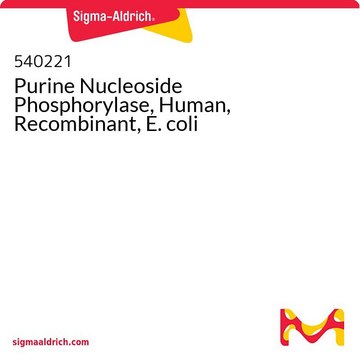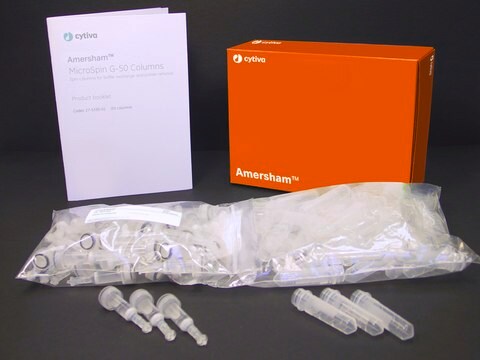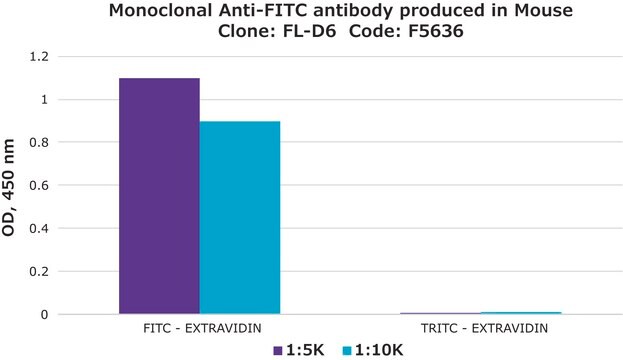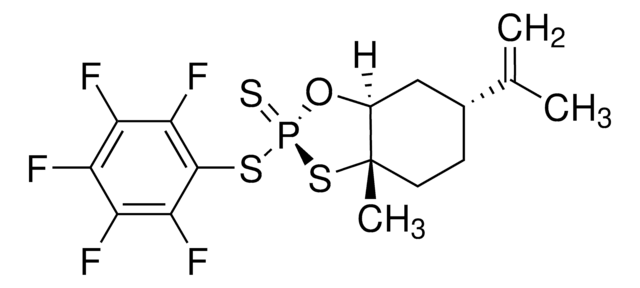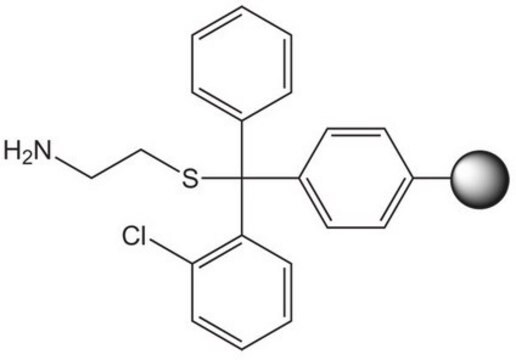N3665
Pyrimidine Nucleoside Phosphorylase from Bacillus subtilis
recombinant, expressed in E. coli, ≥70 units/mg protein
Sinónimos:
PynP
Iniciar sesiónpara Ver la Fijación de precios por contrato y de la organización
About This Item
Productos recomendados
recombinante
expressed in E. coli
Formulario
lyophilized powder
actividad específica
≥70 units/mg protein
temp. de almacenamiento
−20°C
Descripción general
The roles of the residues in the catalytic active site of pyrimidine nucleoside phosphorylase from Bacillis subtilis have been elucidated using hybrid quantum-mechanical/molecular-mechanical methods.
Acciones bioquímicas o fisiológicas
Pyrimidine nucleoside phosphorylase functions in the nucleotide synthesis salvage pathway by catalyzing the reversible phosphorolysis of pyrimidines. Both uridine and thymidine are substrates.
Definición de unidad
One unit will convert 1 μmole each of 2′-deoxyuridine and phosphate to uracil and 2-deoxyribose 1-phosphate per minute at pH 7.4 and 37 °C.
Palabra de señalización
Danger
Frases de peligro
Consejos de prudencia
Clasificaciones de peligro
Resp. Sens. 1
Código de clase de almacenamiento
11 - Combustible Solids
Clase de riesgo para el agua (WGK)
WGK 1
Punto de inflamabilidad (°F)
Not applicable
Punto de inflamabilidad (°C)
Not applicable
Elija entre una de las versiones más recientes:
Certificados de análisis (COA)
Lot/Batch Number
¿No ve la versión correcta?
Si necesita una versión concreta, puede buscar un certificado específico por el número de lote.
¿Ya tiene este producto?
Encuentre la documentación para los productos que ha comprado recientemente en la Biblioteca de documentos.
Xue-Feng Gao et al.
Journal of structural biology, 154(1), 20-26 (2006-02-14)
Pyrimidine nucleoside phosphorylase (PYNP) catalyzes the reversible phosphorolysis of pyrimidines in the nucleotide synthesis salvage pathway. We have built a model of a closed active conformation of the three-dimensional structure of PYNP from Bacillus subtilis. Using docking, molecular dynamics, and
A Danchin
DNA research : an international journal for rapid publication of reports on genes and genomes, 4(1), 9-18 (1997-02-28)
Genome comparison permits identification of chromosome regions conserved during evolution. Bacillus subtilis and Escherichia coli are so distant that there exists very few conserved landmarks in their genome organisation. Analysis of the conserved cmk rpsA cluster pinpointed the importance of
K Okuyama et al.
Bioscience, biotechnology, and biochemistry, 60(10), 1655-1659 (1996-10-01)
The pyrimidine nucleoside phosphorylase (Py-NPase) of Bacillus stearothermophilus TH 6-2 is a dimer of 46-kDa subunits and catalyzes the reversible phosphorolysis of uridine and thymidine. The gene encoding this pyrimidine nucleoside phosphorylase (pyn gene) has been cloned and sequenced from
T Hamamoto et al.
Bioscience, biotechnology, and biochemistry, 60(7), 1179-1180 (1996-07-01)
The purine nucleoside phosphorylase (Pu-NPase) and the pyrimidine nucleoside phosphorylase (Py-NPase) have been purified from Bacillus stearothermophilus TH 6-2. The Pu-NPase is a trimer of 30-kDa subunits and the Py-NPase is a dimer of 46-kDa subunits. The isoelectric points of
M J Pugmire et al.
Structure (London, England : 1993), 6(11), 1467-1479 (1998-11-18)
Pyrimidine nucleoside phosphorylase (PYNP) catalyzes the reversible phosphorolysis of pyrimidines in the nucleotide synthesis salvage pathway. In lower organisms (e.g. Bacillus stearothermophilus) PYNP accepts both thymidine and uridine, whereas in mammalian and other higher organisms it is specific for thymidine
Nuestro equipo de científicos tiene experiencia en todas las áreas de investigación: Ciencias de la vida, Ciencia de los materiales, Síntesis química, Cromatografía, Analítica y muchas otras.
Póngase en contacto con el Servicio técnico